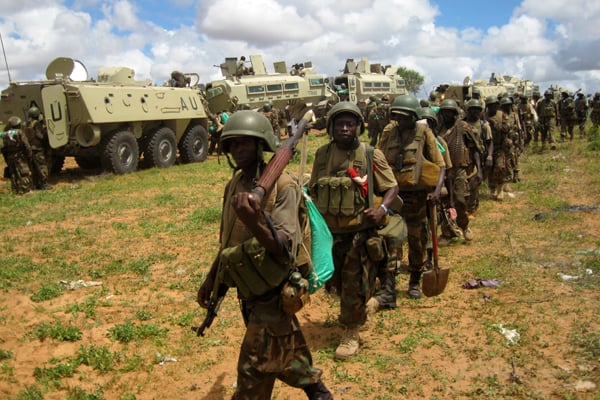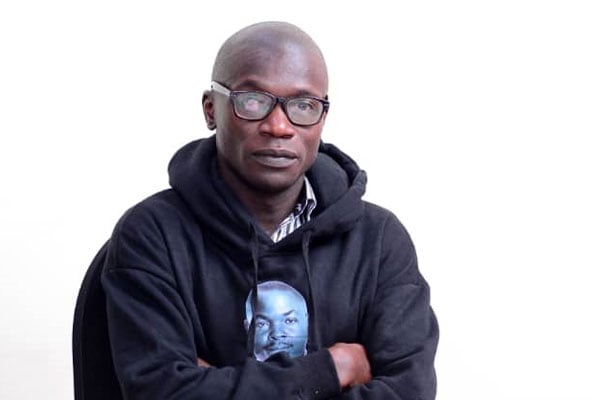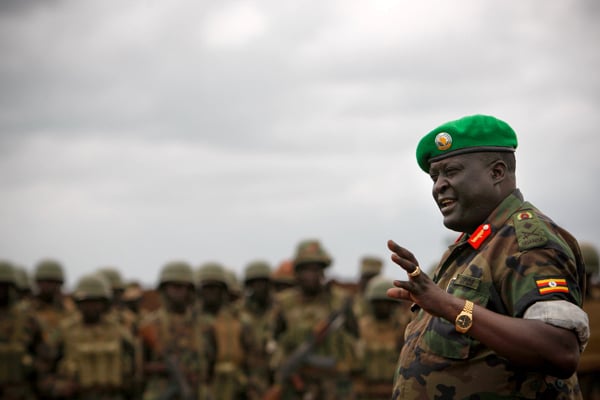Prime
Will UPDF, allies win war against al-Shabaab?

A group of UPDF personnel deployed in Somalia in 2014. PHOTO/ FILE
What you need to know:
- With Uganda forces still leaking its wounds following brutal attack by the al-Shabaab militants on its base in Somalia, Derrick Kiyonga writes that many have asked Kampala to have an exit plan.
Sixteen years after Uganda People’s Defence Forces (UPDF) joined what was known as African Union Mission in Somalia (Amisom), but it has since been christened African Union Transition Mission in Somalia (Atmis), its army came under probably the biggest attack when al-Shabaab, which means the youth, overran its base in Bulo Marer, prompting some to ask for Kampala to craft an exit plan.
“I don’t think [President] Museveni thinks about ending this intervention in Somalia because it makes him relevant in the geopolitics of the region. But Somalia is for Somalis. All foreign forces will one day leave,” says Kira Municipality Member of Parliament (MP) Ibrahim Ssemujju Nganda, who has been critical of Uganda’s military intervention in the region.
The most brutal attack al-Shabaab has carried out on this regional peacekeeping force, backed by the United Nations and African Union, was in January 2016 when they attacked a Kenyan army camp in El Adde, killing 200 soldiers.
In respect to Uganda, before the Bulo Marer attack, the biggest attack recorded was in 2019 when the al-Shabaab militants overran their base in Janaale, killing 19 soldiers.
Yet a year later, an investigation by Monitor revealed that it was easy for al-Shabaab to penetrate Ugandan defences because the soldiers had enduring shortages in equipment, coupled with operational blunders.
Repelling militants
To repel the determined militants, and to support the infantry, the Monitor investigation revealed that the detachment had one 14.5mm and one 12.7 mm anti-aircraft gun, as well as 83mm and 60mm general purpose machine guns and assault rifles. This proved not much of the al-Shabaab.
In the latest attack, it’s President Museveni who, without giving a figure of how many soldiers Uganda lost, painted a picture of how UPDF were unprepared for the attack.
“Those defences are quite strong, although they are guarded by light weapons. There were two tanks, two 14.5mm anti-aircraft guns, and a 107mm Katyusha rocket launcher. Some of the soldiers there did not perform as expected and panicked, which disorganised them and the al-Shabaab took advantage of that to overrun the base and destroy some of the equipment,” Museveni said in a statement, adding that the panic, it seems, was totally unnecessary because both the anti-tank ditch and Ugandan soldiers had destroyed the three explosive-laden vehicles outside the forward operating base.
This unfortunate incident, an angry Museveni said, should be used to remind all those concerned, that operations in Somalia and other theatres, are combat missions and not welfare missions where you can access UN allowances.
“It is criminal for anybody involved, to send into such a theatre a soldier who is either not suited for that mission or not properly prepared for it. Details will come out after the BOI (board of inquiry) has finished its work,” Museveni said.
With soldiers deployed in Somalia said to be earning $400 (about Shs1.5m) per month, which is lucrative when compared to $104 (about Shs400,000) per month earned by lowest ranking soldiers, Museveni later doubled on his claim that “new crop” of commanders are making of use the lucrative allowances from Somalia as a way of earning jobs for their close relatives.
“It seems at some stage, some of the people who organise put names of their bodyguards, personal assistants, and cooks. They create some sort of ad-hoc instead of integral units,” said Museveni while speaking at the retreat of the National Resistance Movement (NRM) MPs in the central district of Kyankwanzi.
“The investigation will go on and you will see. Somalia is a very dangerous place, if you go there without a plan, you end up in a bad situation for yourself. Some of these people do not look at the mission but the money.”
It wouldn’t be the first-time corruption in cited in Uganda’s mission in Somalia since several commanders have from time to time been accused of misuse of funds meant for the maintenance of motorised infantry vehicles, theft, sale of fuel, sexual harassment, conduct prejudicial to good order and discipline, failure to exercise command and control over subordinates and ill-treatment of juniors, inter-alia.
Uganda, which has more than 6,000 troops in Somalia, is the biggest contributor to this mission and experts have insisted that Museveni has used this deployment as leverage over the West which is keen to use proxies to fight terrorism in the Horn of Africa.
“This is not Uganda’s war,” Yusuf Serunkuma, a socio-political commentator based at Makerere University, says. “It’s the West’s war and they have to use African countries.”
Kampala pitched its intervention in Somalia, insisting that pacifying the country would stem the flow of guns in the region.
“The small arms proliferation in the region comes from Somalia. We have an arms corridor from the Horn of Africa to eastern DRC (Democratic Republic of the Congo) and Uganda is at the centre,” army spokesperson Brig Felix Kulayigye told the media in 2007.
Dangers of instability
“Whoever opposes deployment does not see the dangers of instability in Somalia. If we want to address small arms, we must address the question of failed states in the region.”
However, in her book Another Fine Mess: America, Uganda, And the War on Terror, American journalist and researcher Helen Epstein says Museveni exploited the West following UPDF’s deployment in war-torn Somalia in the early 2000s.
In September 2009, Ms Epstein says, the al-Shabaab-inspired suicide bombers postured as UN workers and killed 17 Amisom soldiers, including the Burundian Amisom deputy force commander, and Mr Museveni saw an opportunity out of this mess.
“After that disaster, Museveni held a series of meetings with US officials in Entebbe and on the sidelines of the UN Security Council. Joining him were (former US president Barack) Obama’s ambassador to the UN Susan Rice, US ambassador to Uganda Jerry Lanier, and Johnnie Carson, now in charge of African Affairs at State,” she writes.
“Give me more weapons, more money, more troops and a mandate to fight al-Shabaab,” Museveni reportedly told the Americans, according to Epstein, “Or I’ll pull my men out of Somalia.”
The Americans were still contemplating over this ultimatum, according to Epstein, when on July 11, 2010, al-Shabaab suicide bombers blew themselves up at Kyadondo Rugby Grounds and the Ethiopian Village Restaurant in Kampala where crowds were watching the World Cup final, killing about 70 people.
“The Americans and Europeans ponied up. Funding for Amisom greatly increased and its mandate changed from ‘peacekeeping’ to ‘peace enforcement’,” Ms Epstein writes.
In fact, in 2014, Obama’s administration greenlighted America’s military package for Uganda and consequently, a US congressional committee received a letter from the Defence Department which indicated that Uganda was eligible to receive military backing worth $12.6m for what they termed as “counterterrorism programmes”.
In 2017, Museveni told American officials that Uganda was willing to deploy 5,000 additional troops provided that the West commits to increasing funding, and donating equipment, force enablers, and multipliers such as attack helicopters.
Museveni, it’s said, never got any commitments from the West as he had wanted and as years have gone by the West’s priorities seem to have changed and this has been indicated in how funding directed towards Atmis have dwindled.
In 2022, the European Union (EU), which remains the major Atmis financial contributor, registered a funding shortfall which was reported to be around $27.55 million.
Still, the shortfall has considerably increased in 2023 forcing Bankole Adeoye, commissioner for political affairs, peace and security, African Union Commission to beseech bilateral and international partners to help fill the $89 million funding gap, further warning that if Atmis does not have the funds to operate effectively in the coming months before the scheduled handover in December 2024, “it may mean that al-Shabaab will eventually take over the responsibilities of a state in Somalia”.
Ugandan forces and by extension Atmis – which besides Uganda, has Burundi, Ethiopian, Djibouti, and Kenyan forces – claim to have far-reaching achievements, such as recapturing of various swathes of territory hitherto under the control of al-Shabaab and various other armed opposition groups and the expansion of territorial space in which Somali central government now head by President Hassan Sheikh Mohamud could project their authority.
Down, but not out
But al-Shabaab hasn’t been defeated and controls major supply routes to towns and, through taxation and judicial services, exerts influence and it has regularly launched attacks and assassinations.
“Museveni was in the bush for five years and managed to put together a professional army, but for all the 16 years Uganda has been in Somalia, it has failed to train an army that can fight al-Shabaab on its own. Nothing is going to change in the remaining years of Atmis,” Ssemujju says.
Museveni last year met all heads of state – Hassan Sheikh Mohamud (Somalia), Ismail Omar Guelleh (Djibouti), Evariste Ndayishimiye (Burundi), William Ruto (Kenya) and Demeke Mekonnen (Ethiopia) – that are contributing forces to Atmis in the lakeside town of Entebbe and the discussions centred around procedures to implement the Somali Transition Plan which details the handover of security responsibilities to the Federal Republic of Somalia by December 2024.
However, many predict that should Atims troops pull out, Somalia might face a similar situation that Afghanistan faced in 2021.
“Once the Americans withdrew after years of occupation the Taliban took over. The central government that was intentionally backed couldn’t defend itself. The same thing is going to happen in Somalia. If the UPDF can’t detect 800 militias moving closer to its base, how will the Somali soldiers perform?” Ssemujju asks.
The best exit plan for Uganda, Serunkuma says, is by talking to al-Shabaab. “You can’t have a peaceful Somalia without talking to al-Shabaab. They are part of that country, you have to talk to them.”





